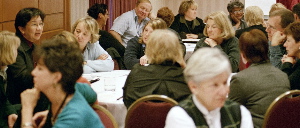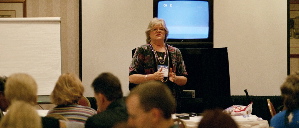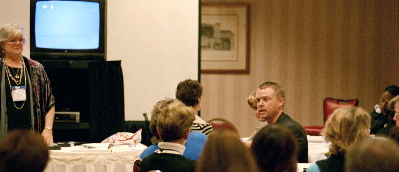|
|
| Vol 13|No 5|January|2004 | |
|
Please feel free to email this article to a friend, a principal, a parent, a colleague, a teacher librarian, a college professor, a poet, a magician, a vendor, an artist, a juggler, a student, a news reporter or anyone you think might enjoy it. Other transmissions and duplications not permitted. (See copyright statement below).
Standards for Robust and Effective Professional Development Few school districts have made an explicit commitment to robust adult learning programs that are adequately funded and anchored in research-based strategies. Effectiveness requires a clearly articulated set of beliefs that shape both the invention and the implementation of the programs. NSDC offers a superb set of standards that a district can adapt, adopt and then employ to shape the learning opportunities for the teaching staff - NSDC Standards for Staff Development. Click on any of the standards below for an explanation as well as a research base to validate the standard. Click here to purchase a printed copy of these standards from NSDC. "School board adoption of standards is a first step," by Stephanie Hirsh, September 2003 Results Once the standards have been adopted, the invention process should move ahead through a needs assessment. A Standards Self-Assessment instrument available is available in PDF format at http://nsdc.org/standards/about/selfassessment.cfm. "Complete directions for facilitation and a scoring guide are included along with the four-page assessment itself." This exercise will help a district team to set priorities for growth and change.
A Source for Research-Based Strategies NSDC provides a free comprehensive online library for educators seeking research findings to guide decision-making and planning. The scope, depth and value of this collection is remarkable. Market Segmentation Unfortunately, educators sometimes focus their conference attendance, their memberships and their reading too narrowly so that those with a major responsibility for educational technologies may not avail themselves of resources such as NSDC or curriculum groups such as ASCD. In a similar pattern, one may not find many classroom teachers or principals attending conferences of teacher librarians (AASL) or higher ed researchers (AERA). This segmentation stands in the way of cross fertilization and helps to explain how a venture as robust as the networking of schools during the roaring nineties might have proceeded with so little attention to adult learning concepts and with such meagre investment in professional development. It also helps to explain how organizations can still promote models of TCO (Total Cost of Ownership) that leave out professional and organizational development.
|
|
Back to January Cover
Credits: The photographs were shot by Jamie McKenzie . Copyright Policy: Materials published in From Now On may be duplicated in hard copy format if unchanged in format and content for educational, nonprofit school district and university use only and may also be sent from person to person by email. This copyright statement must be included. All other uses, transmissions and duplications are prohibited unless permission is granted expressly. Showing these pages remotely through frames is not permitted. FNO is applying for formal copyright registration for articles. Unauthorized abridgements are illegal.
|
 From Now On
From Now On


